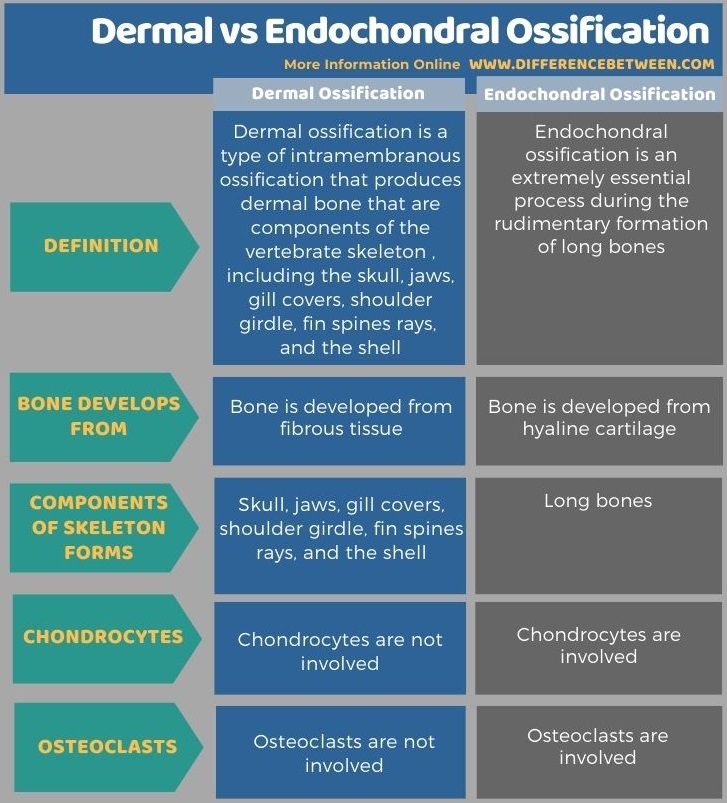The key difference between dermal and endochondral ossification is that dermal ossification is the development of bone from fibrous membranes, while endochondral ossification is the development of bone from hyaline cartilage.
Ossification or osteogenesis is the formation of bones from osteoblast cells. Ossification is different from calcification. Ossification takes place approximately six weeks after fertilization in an embryo. Dermal ossification is the development of bone from fibrous membranes, while endochondral ossification is a type of development of bone from hyaline cartilage. Dermal ossification is a type of intramembranous ossification that produces dermal bone (investing bone or membrane bone) forming components of the vertebrate skeleton, including much of the skull, jaws, gill covers, shoulder girdle, fin spines rays, and the shell, while endochondral ossification is the essential process of rudimentary formation of long bones.
CONTENTS
1. Overview and Key Difference
2. What is Dermal Ossification
3. What is Endochondral Ossification
4. Similarities Between Dermal and Endochondral Ossification
5. Side by Side Comparison – Dermal vs Endochondral Ossification in Tabular Form
6. Summary
What is Dermal Ossification?
Dermal ossification is a type of intramembranous ossification that produces dermal bone that forms components of the vertebrate skeleton, including the skull, jaws, gill covers, shoulder girdle, fin spines rays, and the shell. Intramembranous ossification is an essential process during the natural healing process of bone fractures and the rudimentary formation of bones of the skull. The mammalian skull is an ossified structure where flat dermal bones of the calvaria craniofacial region and the mandible are formed from dermal ossification.

Figure 01: Dermal Ossification
In dermal ossification, the bone is developed from fibrous tissue. The dermal bone is formed within the dermis. The dermis is a layer of skin between the epidermis and subcutaneous tissues. It typically consists of dense irregular connective tissue. The function of dermal bone formed from dermal ossification is conserved throughout the vertebrates. However, there is variation in shape and in the number of roofing bones in the skull and postcranial structures. The dermal bones that are formed from dermal ossification are also known to be involved in ecophysiological implications such as the heat transfers between the body and the surrounding environment. This is evident in crocodiles basking in the sun. These dermal bones also buffer the respiratory acidosis that is evident in crocodiles and turtles. These ecophysiological functions of dermal bones rely on the set-up of a blood vessel network within them.
What is Endochondral Ossification?
Endochondral ossification is an extremely essential process during the rudimentary formation of long bones. It helps the growth of the length of the bones and natural healing of the bone fractures. In endochondral ossification, the bone is developed from hyaline cartilage. In long bones, chondrocytes produce a template of the hyaline cartilage diaphysis. Due to developmental signals, the matrix begins to calcify. Chondrocytes die due to calcification as it prevents the diffusion of nutrient to the matrix. This opens up cavities in the diaphysis cartilage. The blood vessels invade the cavities. The osteoblast and osteoclast modify the calcified cartilage matrix into a spongy bone. Later, osteoclast breaks down the spongy bone to form marrow in the centre of the diaphysis. Moreover, the dense irregular connective tissue forms a sheath called the periosteum around the bone. This periosteum helps in attaching the bone to surrounding tissues, tendons, and ligaments. As the cartilage cells at the epiphyses divide, the bone continues to grow and elongate.

Figure 02: Endochondral Ossification
In the last stages of bone development, the centres of the epiphyses (the end part of the long bone) start to calcify. The secondary ossification centres form in the epiphyses. Osteoblasts and blood vessels enter these areas and convert hyaline cartilage into spongy bone. Until adolescence, hyaline cartilage is present at the epiphyseal plate. The epiphyseal plate is the region between diaphysis and epiphysis that is responsible for the lengthwise growth.
What are the Similarities Between Dermal and Endochondral Ossification?
- Dermal and endochondral ossification are types of ossification.
- Both assist bone development.
- They are both using osteoblast activity.
- Both processes happen in vertebrates.
- These processes heal bone fractures.
What is the Difference Between Dermal and Endochondral Ossification?
Dermal ossification is a type of intramembranous ossification that produces dermal bone, while endochondral ossification is the essential process of rudimentary formation of long bones. So, this is the key difference between dermal and endochondral ossification. Moreover, in dermal ossification, the bone is developed from fibrous tissue. In contrast, in endochondral ossification, the bone is developed from hyaline cartilage.
The below infographic lists the differences between dermal and endochondral ossification in tabular form.

Summary – Dermal vs Endochondral Ossification
Bone formation is a replacement process. During the ossification, tissues are replaced by bone. Dermal ossification is a type of intramembranous ossification that produces dermal bone from a fibrous tissue, which forms components of the vertebrate skeleton such as the skull. In endochondral ossification, the bone is formed by replacing hyaline cartilage. Thus, this is the summary of the difference between dermal and endochondral ossification.
Reference:
1. “Bone Growth and Development.” Lumen, Available here.
2. Biga, Lindsay M., et al. “6.4 Bone Formation and Development.” Anatomy Physiology, OpenStax/Oregon State University, Available here.
Image Courtesy:
1. “611 Intramembraneous Ossification” By OpenStax College – Anatomy & Physiology, Connexions Web site. Jun 19, 2013. (CC BY 3.0) via Commons Wikimedia
2. “608 Endochrondal Ossification” By OpenStax College – Anatomy & Physiology, Connexions Web site, Jun 19, 2013. (CC BY 3.0) via Commons Wikimedia
ncG1vNJzZmivp6x7pbXFn5yrnZ6YsqOx07CcnqZemLyue8OinZ%2Bdopq7pLGMm5ytr5Wau26wxKukmqRdlrulecSnm6ibmKS7pb7ApWSoq6Oes6qvwK2gqKZf